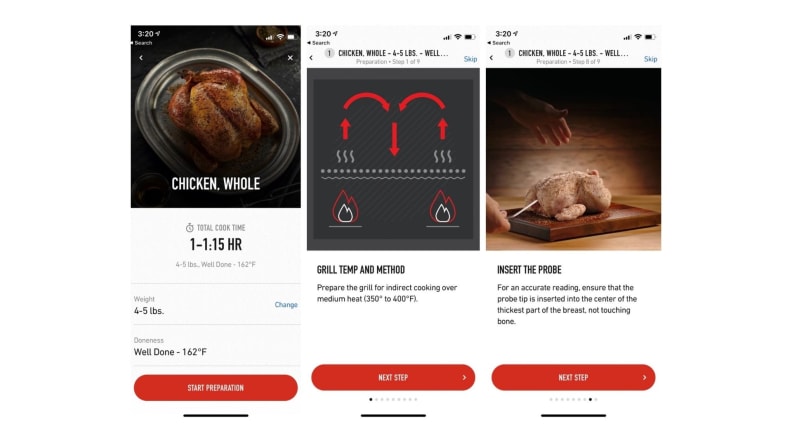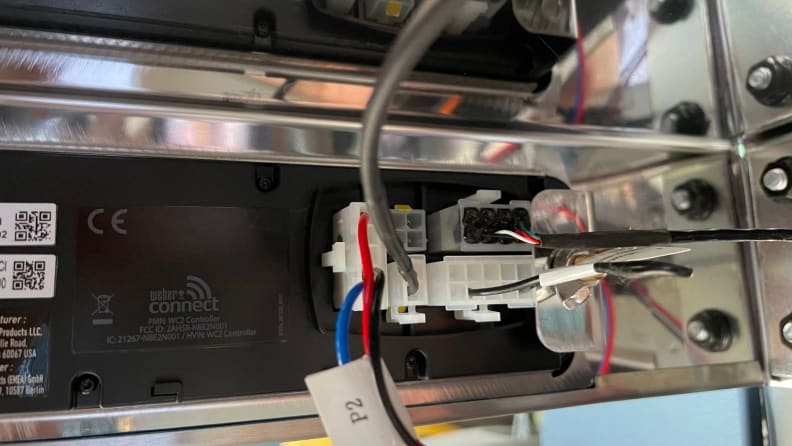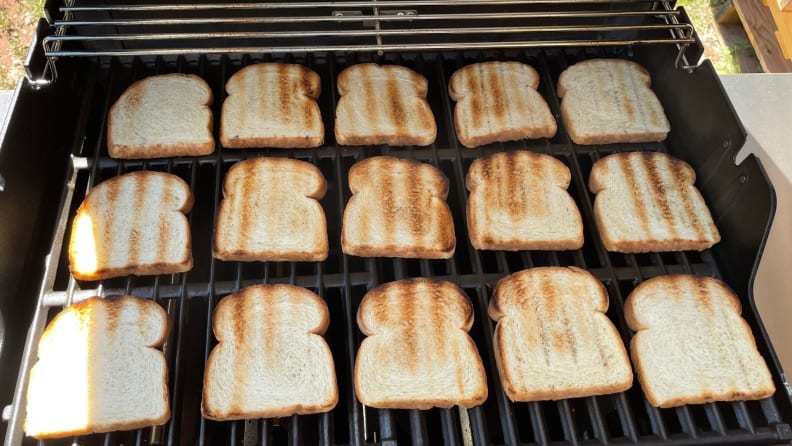Is this smart grill better than a standard gas grill?
We put the Wi-Fi-enabled Weber Spirit SX-315 Grill to the test.
 Credit:
Reviewed / Weber
Credit:
Reviewed / Weber
Recommendations are independently chosen by Reviewed's editors. Purchases made through the links below may earn us and our publishing partners a commission. Prices were accurate at the time this article was published but may change over time.
Grilling has long been considered an art that requires hours of practice. One cannot simply become a barbecue pitmaster; one must first labor over the hot grill, weekend after weekend, mastering the skills required to cook a perfect burger, steak, or pork shoulder. Of course, today’s technology may render that kind of old-school thinking moot. Armed with a good meat thermometer, amateurs become empowered with knowledge that can turn them into pros with the click of a button.
When we tested the Weber Connect Smart Grilling Hub, we were impressed at the possibilities provided by this new technology. Connecting a probe thermometer to a smartphone app puts more information in the hands of the griller, delivering more than just temperature information. It has built-in programs that helps beginners know when to flip a steak or wrap a brisket, giving them the confidence to develop their skills and achieve perfect results, every time.
So when we learned that technology was integrated into Weber’s new line of smart grills, we had to pick one up to see how it worked. We tested the Weber Spirit SX-315 to see if it could out-perform a standard Weber gas grill.
What is a smart grill?

You’ll need to pair your grill with the Weber Connect app via Bluetooth and connect it to your Wi-Fi network the first time you power it up.
Weber’s smart grilling technology turns a regular gas grill into a smart grill. The brand added LED displays to the side tables of its top-selling Genesis and Spirit gas grill line: Genesis EX-315, Genesis EX-335, Genesis SX-335, and Spirit SX-315. These grills not only have smart technology built into the table, but they also connect the grill to the Weber Connect app via Wi-Fi or Bluetooth. That allows users to view the ambient temperature of the grill, monitor the temperatures of food cooking with the built-in probe thermometers, use the app’s recipes and guided grilling programs, or receive low-fuel alerts.
How do Weber’s smart grills work?

Weber’s smart grills have a few extra steps that aren’t typical for gas grills, like this battery-powered LED panel that's also wired into the ambient temperature probe and propane sensors.
When building the grill, Weber’s smart grills have a few extra steps that aren’t typical for gas grills. The LED panel is powered by a battery pack, and it’s also wired into the ambient temperature probe and propane sensors. The assembly guide does a great job of detailing how to hook everything up, and the grill was well designed to hide all these wires so they’re not visible as you’re grilling.
From there, the panel turns on with the touch of any button and off by holding the checkmark button for three seconds. The first time you power the grill, you’ll need to pair it with the Weber Connect app via Bluetooth and connect it to your Wi-Fi network (an optional step to extend the app’s range). Every time thereafter, it finds the app and automatically connects.
The LED display shows the grill’s ambient temperature and the temperature of any plugged-in probe thermometers. You can use the up/down buttons to set a target temperature alert or press the alarm button to set a timer (functions that can also be performed on the app). The display also has lights that turn green, yellow, or red to indicate the propane tank’s fuel level (LP models only) and the battery pack’s charge.
The app not only mirrors the LED display, but it also allows you to select guided grilling programs or recipes. This means you can choose a program for red meat, pork, poultry, lamb, or fish, plug in the probe thermometer, and receive step-by-step grilling assistance. It will send you alerts when you’re at the right temperature to flip or serve.
How we tested

We use slices of white bread to map out the heating pattern across the grill.
We used the same testing protocols to test the Weber Spirit SX-315 as we did when we tested gas grills. To connect to the Weber Connect app, we used an iPhone 12 Pro on iOS 14.6. The Spirit SX-315 has two built-in probe thermometer ports, but we also used a ThermoWorks Chef Alarm (our top pick when testing probe thermometers) to check the probes’ accuracy.
After assembling the grill, we got to work testing the grill at three different heat levels: high heat (all three burners on the hottest setting), low heat (all three burners on the lowest setting), and indirect heat (one burner turned on high).
For our high-temperature cooking test, we timed how long it took for the grill to hit 600°F, an ideal temperature for high-heat searing of steaks, vegetables, and burgers. Once the grill was hot, we placed slices of white bread over the entire surface to map out the heating pattern. This helped us understand if the grill heated evenly and created predictable patterns without noticeable hot or cold spots.
Next, we grilled burgers, spaced two inches apart, cooking them for five minutes per side. After the timer expired, we measured the internal temperature of each burger to ensure they were all within 5 to 10 degrees of each other. Finally, to round out the high-heat tests, we tossed thin-stemmed asparagus onto the cooking grates to see if they fell through.

Indirect heat is the best way to cook food that takes longer than 30 minutes to finish, like this whole chicken.
For the low-temperature tests, we turned all the burners to their lowest position, hoping to see temperatures around 375°F. This is an ideal temperature for slow-cooking foods or grilling delicate items that can’t withstand a grill’s high heat. Chicken drumsticks were the perfect option for this test, and the best grills cooked them in about 30 minutes, creating an even, golden brown skin.
The last test was indirect heat, a cooking method that only uses a few of the burners to create an oven-like environment inside of the grill. It’s the best way to cook food that takes longer than 30 minutes to finish or that would otherwise burn when exposed to high heat—like a whole chicken, a rack of ribs, or a pork shoulder. We measured the grill’s internal temperature after 15 minutes of preheating and cooked a whole chicken.
We also looked at each grill’s aesthetic features and build quality. Do the grills rattle and shake when you roll them around? Are the side tables and side shelves sturdy enough to hold heavy food items? Are there hooks to hang your grilling tools on? Is there a place to store the propane tank, and is it within reach of the hookup hose? Do the grill’s handles get too hot to touch? Is its grease tray catch pan easy to access? After compiling the scores, some of these design choices made a huge difference in the grill’s overall ranking.
What we like about the Weber Spirit SX-315 Smart Grill
Even heat with minimal flare-ups
The Spirit SX-315 performed every bit as well as the non-smart Spirit that topped our list when we tested gas grills. Our burgers cooked remarkably evenly, and there were very few flare-ups thanks to the “Flavorizer bars” (the flame shields built over the gas burners). The grates produced beautiful sear marks over high heat, and our chicken drumsticks cooked evenly over low heat. We were able to get the grill down to 250°F with indirect heat, which is not quite as low as a smoker but plenty low enough to cook a rack of ribs or a pork shoulder.
Plenty of space for regular grilling
The Spirit’s primary cooking area is 424 square inches, which is enough room to comfortably cook 15 burgers. That’s more than enough space for regular grilling and enough for hosting a small backyard barbecue. The warming rack adds another 105 square inches, too.
Fuel Level Monitoring
The worst part of gas grilling is running out of propane mid-cook! We loved the fuel monitor on the LED display, which turns yellow then red when the tank is low. The Weber Connect app also displays the fuel level so you can monitor it from afar. It takes the guesswork out of the equation and ensures you’ll never ruin the barbecue because of lack of fuel.
Wi-Fi connectivity
Bluetooth-connected grills don’t have a large range, so if your grill is far from your house (like mine), it’s easy to drop the connection to your smart thermometer. The ability to hook up the Weber Connect to Wi-Fi greatly extended the range, allowing us to monitor fuel levels and grill temperatures from about 150 feet away. The initial Wi-Fi setup was a bit of a pain, but we were thrilled to see that Weber Connect remembered our device and Wi-Fi network on subsequent cooking sessions.
You can set temperature alerts
While the Spirit SX-315 isn’t smart enough to control the grill temperature, it does provide real-time temperature alerts. You can monitor the grill’s ambient temperature from the app and set an alert when it reaches a specific temperature. That’s helpful for knowing when the grill has preheated, or for helping you get back to the grill to adjust the dials if you need to stay below a set temperature.
Step-by-step cooking instructions and built-in cooking temperatures
Advanced grillers might not need all the prep and cooking instructions included with the Weber Connect app, but they’re extremely helpful for beginners. The cooking programs provide prep tips like preheating and cleaning the grill, whether to use direct or indirect heat, and video instruction for where to insert the probe. It even shows you how to trim and truss a boneless prime rib roast or provide an alert when it’s time to flip your burgers! Of course, if you don’t need this type of info, you can select a target temperature and skip the extra instructions.
When using one of the built-in cooking temperatures, the app also calculates the estimated cooking time and provides a countdown to when your food is done. While the time estimates aren’t 100% accurate, they gave us a general idea of how long we had before the next step.
What we don’t like about the Weber Spirit SX-315 Smart Grill
The grill is hard to use without the electronics
While we loved the smart features of the Spirit SX-315, we would be remiss if we overlooked the fact that it relies on electronics to function properly. The original shipment we received happened to have a defective electronics package. Weber’s customer service was fantastic and sent us a replacement right away, but the grill was hard to use without the LED panel and app connectivity. There was no way of knowing the temperature inside the grill since the lid doesn’t have a built-in thermometer.
The probes can’t be calibrated
While we found the built-in probes to be as accurate as our stand-alone probe thermometer, they can’t be calibrated. Thermometer accuracy can drift over time, especially when it’s been exposed to high temperatures. Inaccurate thermometers aren’t very useful, especially when cooking foods like poultry where temperature is crucial to food safety. They’re not terribly expensive, but you will have to buy a new probe if the original doesn’t record 32°F in ice water.
The app doesn’t include historical data
The Weber Connect app is great for alerts, monitoring temperatures, and providing step-by-step cooking instructions, but it lacks historical information. We wanted to see what we cooked in previous sessions, how long it took, and the peak vs. target temperature—as well as temperature graphs of the ambient and probe temperatures. This information might be overkill for some, but it’s useful for cooks looking to improve their grilling game.
Warranty
Weber’s Spirit grills are covered by a 10-year warranty on the cookbox, lid assembly, and stainless steel burner tubes. The cooking grates and Flavorizer bars have a five-year warranty, while any other remaining parts are covered by a two-year warranty. The warranty covers material defects, but it doesn’t apply to normal wear and tear (cosmetic damages, discoloration not related to material defects, scratches and dents, surface rust, etc.). Like most warranties, it isn’t transferable, so it applies to the original owner only.
Should you buy a smart grill?
The Spirit SX-315 performed just as well as the Spirit II E-310 (our top pick overall for gas grills), so we have no hesitations recommending it as a solid gas grill. It’s also the most affordable of Weber’s smart grill series. That said, at the time this article was published, it’s over $300 more than the non-smart version of the grill, and the price goes up if you opt for one of the larger Genesis models.
Is that extra money well spent? It really just depends on your experience level and how you like to cook. If you only use your grill to grill quick-cooking items like burgers, pork chops, kebabs, or fish, you probably don’t need remote tracking with Wi-Fi-connected apps and temperature alerts. You also don’t need to rush out to get a new smart grill if you purchased one recently. The Weber Connect Smart Grilling Hub is available as a stand-alone purchase, and it offers much of the same functionality as the smart grill. As a bonus, it works with any grill brand.
On the other hand, if you’re in the market for a new gas grill and you want one that’s connected with the latest technology, you really can’t go wrong with the Spirit SX-315. The smart features are great for beginner grillers, and they’ll come in handy for even the most experienced cooks who plan to grill larger cuts like whole chickens, brisket, pulled pork, or roasts.





